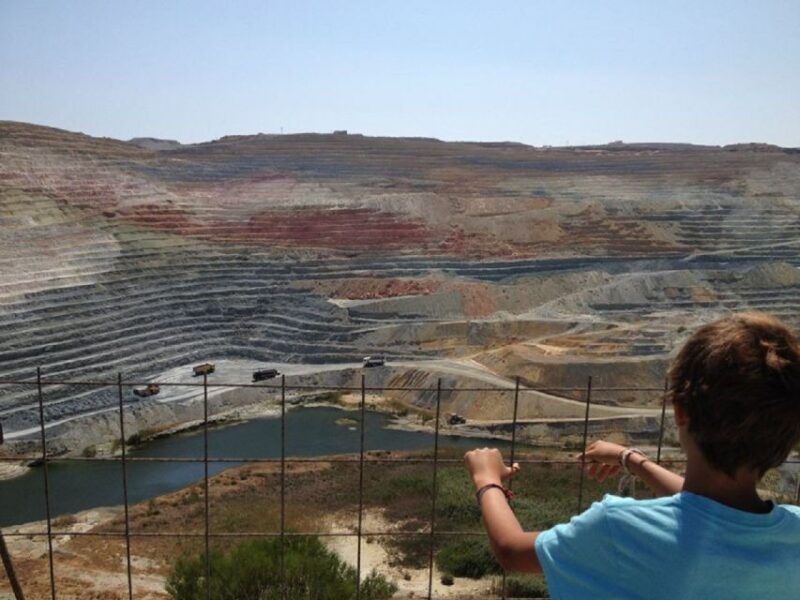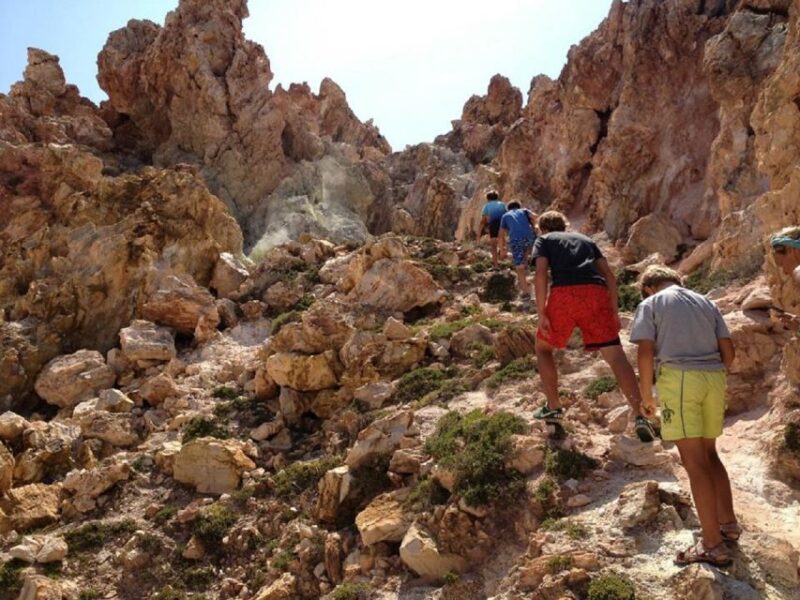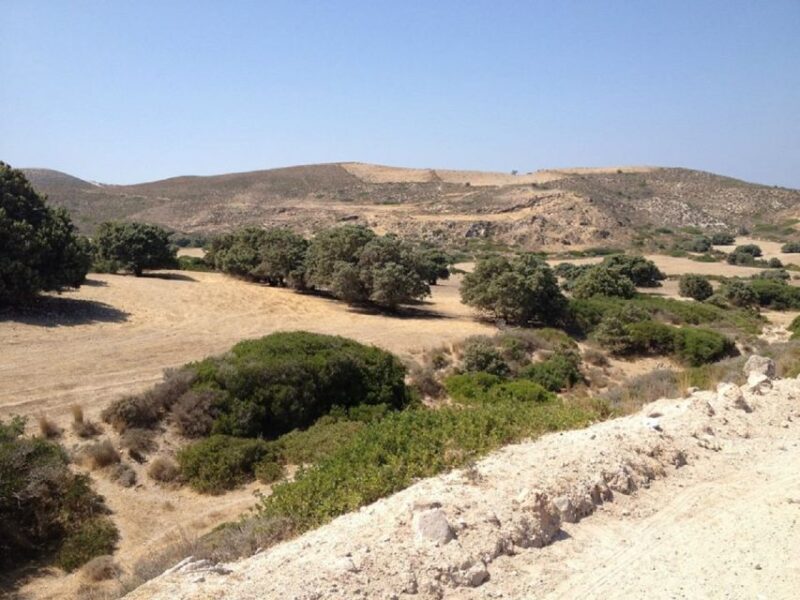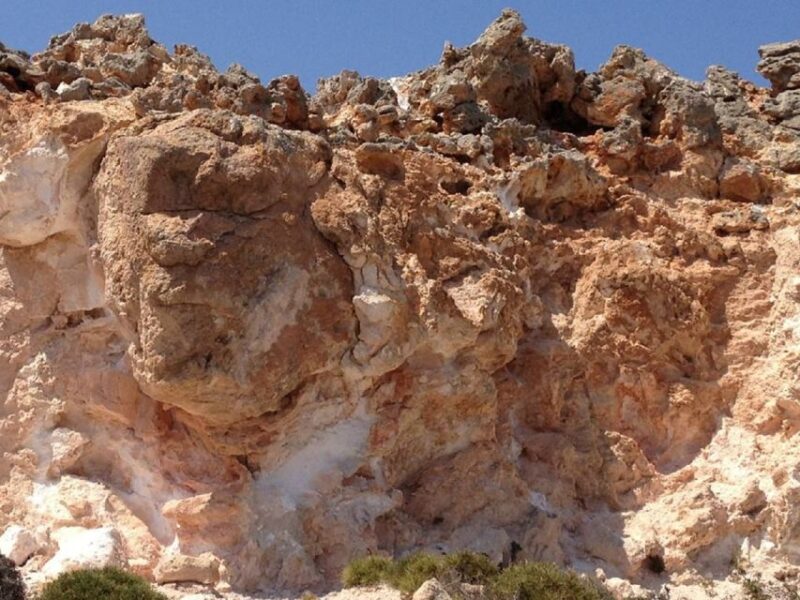The 5-hour Milos Geology and Mining Tour takes visitors on an immersive exploration of the volcanic island’s rich geological and industrial heritage. The tour starts at the Mining Museum, showcasing the island’s obsidian collection and mining legacy. Highlights include the salt fields, Crater of Fyriplaka, sulfur mines, and the Aggeria bentonite mine. Visitors will gain insights into Milos’ unique volcanic formations, the challenges faced by its miners, and the enduring significance of its natural resources. Those eager to delve deeper into Milos’ captivating story can expect an enlightening and memorable experience.
Key Points

- The 5-hour tour explores the volcanic geology and rich mining history of the island of Milos, starting at the Milos Mining Museum in Adamas.
- The tour highlights include visiting the Milos Mining Museum’s obsidian collection, salt fields, Crater of Fyriplaka, sulfur mines, and the active Aggeria bentonite mine.
- The Milos Mining Museum showcases the island’s volcanic heritage and mining legacy through mineral samples, fossils, mining equipment, and interactive exhibits.
- The tour provides insights into the formation of the salt fields and the port of Kanava, which was a historic hub for mining exports and maritime trade.
- The tour involves navigating uneven terrain and steep inclines, so it may not be suitable for individuals with mobility impairments.
Tour Overview and Duration

The Geology and Mining Tour in Milos lasts 5 hours and starts at the Mining Museum of Milos in Adamas, with pickup available from hotels in Pollonia and Adamas.
Participants will learn about the volcanic geology of the island and discover the history of mining on Milos. The tour includes a visit to the Milos Mining Museum, where they’ll see the impressive Obsidian collection.
Visitors will also explore the island’s salt fields, the Crater of Fyriplaka, the Sulphur Mines, and the Aggeria Mine, the largest active open-cast bentonite mine.
Throughout the tour, guests will receive bottled water, a midday snack, and a map to guide them.
You can also read our reviews of more tours and experiences in Milos.
Highlights of the Tour

Highlights of the tour include learning about the volcanic geology of Milos and discovering the island’s rich mining history.
Visitors will explore the Milos Mining Museum and its impressive Obsidian collection, as well as venture to the island’s salt fields, the Crater of Fyriplaka, the Sulphur Mines, and the Aggeria Mine, the largest active open-cast bentonite mine.
At the salt fields, guests will learn about the port of Kanava, while the Crater of Fyriplaka offers a glimpse of century-old cedar trees.
The tour also takes visitors to the abandoned miners’ community and the Sulphur Mines, providing a deeper understanding of Milos’ mining legacy.
Milos Mining Museum

The Mining Museum of Milos anchors the geology and mining tour, showcasing the island’s rich volcanic heritage and centuries-old mining legacy.
Visitors can explore the museum’s impressive collection of mineral samples, fossils, and mining equipment, which provide a rundown of Milos’ geological evolution and its long-standing tradition of resource extraction.
The museum’s centerpiece is its extensive obsidian collection, featuring diverse varieties of the volcanic glass that have been used by humans for millennia.
Through interactive exhibits and guided explanations, the museum brings to life the story of Milos’ miners, who’ve played a vital role in shaping the island’s economy and culture over the generations.
After exploring the Milos Mining Museum, the tour then visits the island’s historic salt fields and the port of Kanava, where participants can learn about the significance of these sites to Milos’ mining and maritime heritage. The salt fields, a natural phenomena resulting from the island’s volcanic activity, have been harvested for centuries, providing a valuable resource for the local economy. The port of Kanava, once a bustling hub for the island’s mining exports, offers a glimpse into Milos’ past as a center of trade and industry. Visitors can explore the remnants of the port’s infrastructure and gain a deeper understanding of the island’s rich history.
| Site | Significance |
|---|---|
| Salt Fields | Natural resource harvested for centuries |
| Port of Kanava | Historic hub for mining exports and maritime trade |
| Volcanic Activity | Influenced the formation of the salt fields |
Crater of Fyriplaka

One of the highlights of the Geology and Mining Tour is a visit to the Crater of Fyriplaka, where participants can admire century-old cedar trees thriving within the volcanic landscape. The crater, formed by a phreatomagmatic eruption, offers a unique and captivating glimpse into Milos’ geological history.
Visitors will be struck by the stark contrast between the lush greenery of the ancient cedars and the rugged, lunar-like terrain surrounding them.
The Crater of Fyriplaka is a must-see for anyone interested in the island’s volcanic origins and the resilience of its natural ecosystems.
The tour guide will provide fascinating insights into the formation and evolution of this remarkable geological feature.
Exploring the crater’s edge offers breathtaking views and a profound appreciation for the dynamic forces that have shaped Milos over millennia.
- Full-Day Tour of Milos and Poliegos Small Group Catam With Lunch
- Full-Day Small-Group Cruise in Milos & Poliegos With Lunch
- Milos: Half-Day Speedboat Cruise to Kleftiko With Snorkeling Tour
- From Pollonia: Milos Cruise With Food and Wine
- Half Day Boat Tour to Kleftiko Milos
- From Provatas Milos: Boat Rental to Kleftiko
Sulfur Mines and Miners’ Community

Another stop on the Geology and Mining Tour is the Sulphur Mines and the abandoned miners’ community, offering a glimpse into Milos’ rich industrial heritage.
Tour you will have the opportunity to explore the remnants of the once-thriving sulfur mining operations that played a crucial role in the island’s economic development over the centuries.
They’ll wander through the eerie remains of the miners’ homes, offices, and workshops, imagining the bustling activity and tough lives of the workers who extracted this valuable mineral from the earth.
The tour guide will share insights into the techniques and challenges of sulfur mining, as well as the eventual decline of this industry on Milos.
Aggeria Mine
Finally, the tour visits the Aggeria Mine, the largest active open-cast bentonite mine on the island. This massive mining operation, which spans a vast expanse, offers visitors a remarkable glimpse into Milos’ ongoing geological and industrial heritage.
Visitors can observe the intricate process of extracting and processing the valuable bentonite clay from the open-cast quarry.
The sheer scale of the Aggeria Mine, with its towering walls and expansive pits, showcases the island’s enduring commitment to mining and resource extraction.
Guides provide insights into the modern techniques and technologies employed in this contemporary operation, complementing the historical perspectives gained from earlier stops on the tour.
Exclusions and Recommendations

The tour isn’t suitable for individuals with mobility impairments, as it involves navigating uneven terrain and steep inclines.
Visitors are recommended to bring sunglasses, a hat, sunscreen, and closed-toe shoes to ensure a comfortable and safe experience during the geology and mining exploration.
The tour covers several sites, including the Milos Mining Museum, salt fields, Fyriplaka Crater, and Aggeria Mine, which may pose challenges for those with limited mobility.
Participants should be prepared for a moderately strenuous outing, with some walking and climbing required.
Frequently Asked Questions
What Is the Best Time of Year to Take the Tour?
The best time to take the tour is during the spring or fall when temperatures are mild and comfortable. The summer months can be quite hot, making the outdoor portions of the tour more challenging.
How Much Walking Is Involved During the Tour?
The tour involves a moderate amount of walking. Visitors can expect to walk for several kilometers over uneven terrain, including hiking to and exploring the island’s sulfur mines and volcanic crater. Comfortable, closed-toe shoes are recommended.
Can the Tour Be Customized to Individual Preferences?
The tour can be customized to individual preferences. Customers can discuss their interests with the tour provider and request adjustments to the standard itinerary, such as spending more time at certain sites or focusing on specific aspects of the geology and mining history.
Is Photography Allowed During the Tour?
Yes, photography is generally allowed during the tour. Participants can take pictures at the various stops, including the mining museum, salt fields, and sulfur mines, to capture the geological wonders and historical elements of the experience.
Are There Any Age Restrictions for the Tour Participants?
There are no age restrictions for the tour participants. The tour is suitable for all ages, though it’s recommended that young children be accompanied by an adult due to the nature of the activities involved.
Recap
The Geology and Mining Tour of Milos offers visitors a captivating exploration of the island’s rich geological and mining heritage.
From the Mining Museum to the captivating natural wonders, the tour provides an immersive experience, allowing travelers to uncover the island’s centuries-old story of resource extraction and its impact on the local communities.
This comprehensive journey showcases Milos’ unique volcanic landscape and its enduring significance as a hub for mining and exploration.
You can check if your dates are available here:More Tours in Milos
More Tour Reviews in Milos
Not for you? Here's more things to do in Milos we have recnetly reviewed
- 3 Best Guided Tours In Milos
- 25 Best Cruises And Boat Tours In Milos
- 10 Best Full-Day Tours In Milos
- 2 Best Food Tours In Milos
- 3 Best Private Car With Driver Services In Milos
- 15 Best Lunch Experiences In Milos
- Milos Experience Daily Kimolos Road Trip
- Royal Blue Half Day Private Tour to Polyaigos
- Private Helicopter Transfer From Amanzoe to Santorini
- Yoga & Reiki on Milos Island, Greece
- Private Helicopter Transfer From Milos to Paros
- Milos to Santorini Helicopter Flight
